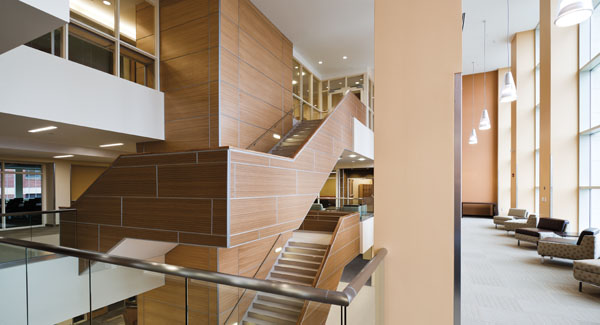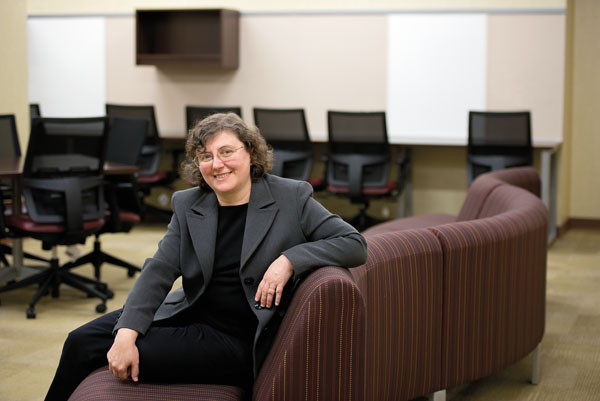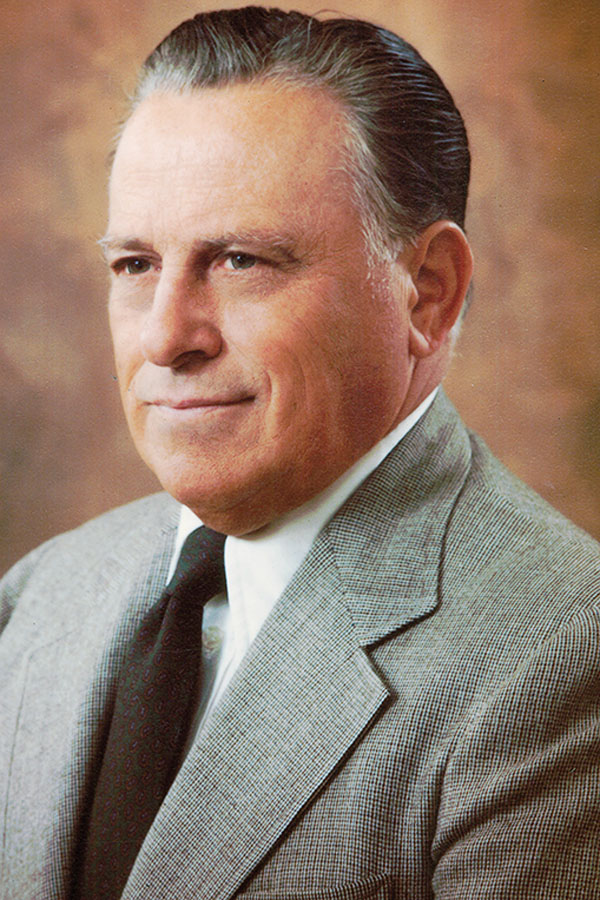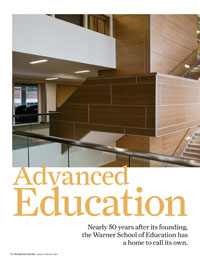Features
 LIGHTING LECHASE: A dramatic atrium named for key supporters and Rochester parents Robin and Timothy Wentworth connects the
second, third, and fourth floors of LeChase Hall, offering a three-story view of the Wilson Quadrangle. (Photo: Adam Fenster)
LIGHTING LECHASE: A dramatic atrium named for key supporters and Rochester parents Robin and Timothy Wentworth connects the
second, third, and fourth floors of LeChase Hall, offering a three-story view of the Wilson Quadrangle. (Photo: Adam Fenster)For the past five decades, the Warner School of Education has been an academic program on the move.
Physically, the University’s graduate programs in teaching and curriculum, counseling, school leadership, higher education, educational policy, human development, and health professions education have had a peripatetic life on campus. There were the early days in Taylor Hall, followed by a span in Lattimore, and for more than a decade, the nearly three dozen Warner faculty have crowded into Dewey Hall on the Eastman Quadrangle.
Since 2000, the school has grown faster than any other academic division within the University, more than doubling in student enrollment and tripling in its support from state and federal grants. At the same time, the school has added several programs aimed at supporting schools in the Rochester area and launched new initiatives to research educational practices to advance K-12 education and policy across the country.
 ROOM TO GROW: Dean Raffaella Borasi says spaces like a study for doctoral students (opposite) provide much-needed facilities for the Warner School’s graduate students, while a children’s book reading room (above) offers K-8 students a space of their own. (Photo: Adam Fenster)
ROOM TO GROW: Dean Raffaella Borasi says spaces like a study for doctoral students (opposite) provide much-needed facilities for the Warner School’s graduate students, while a children’s book reading room (above) offers K-8 students a space of their own. (Photo: Adam Fenster)Transformative Support
 Raymond F. LeChase (Photo: Adam Fenster)
Raymond F. LeChase (Photo: Adam Fenster)
Raymond F. LeChase Hall
 Raymond F. LeChase (Photo: Adam Fenster)
Raymond F. LeChase (Photo: Adam Fenster)Raymond F. LeChase, founder of LeChase Construction Services, was a pioneer in the Rochester construction community, a noted philanthropist, and dedicated supporter of education. A University trustee, R. Wayne LeChase, and his wife, Beverly, made a $3.5 million commitment to the University in recognition of the important role education plays in improving lives and strengthening the community.
The first building on the Wilson Quadrangle in 30 years, the new hall will also be the first dedicated home for the Warner School, providing space for all of Warner’s faculty and students.
In thanking R. Wayne and Beverly LeChase for their support for a new building for the Warner School, Dean Raffaella Borasi noted that their commitment to education joined a history of transformative gifts for the school. Here are a few of the notable names in that recent history:
Warner School of Education
William Scandling made a multimillion dollar naming gift to the school in 1993 in memory of his late wife, Margaret Warner Scandling ’44, a former trustee who had been a leading supporter of the school and its programs. In the new building, a suite of offices that brings together student-related services—admissions, career services, finances, and others—has been named the Margaret Warner and William Scandling Center for Student Support in recognition of the Scandlings’ commitment to the school. William Scandling also established the Michael W. Scandling Professorship in Education, currently held by Joanne Larson, chair of the teaching and curriculum program, to honor his son.
Wentworth Atrium
Robin and Timothy Wentworth are the parents of a Rochester graduate who is now a teacher and of a current student who is a member of the Class of 2016. In recognition of their $1 million gift to the school, the dramatic three-story atrium is named in their honor.
Genrich-Rusling Room
Ellen Rusling ’66W, ’79W (MA) and her husband, Thomas, provided support for a multipurpose room for events, meetings, and study. The space is named in memory of Ellen Rusling’s father, Willard A. Genrich Sr., who was a former chancellor of the New York Board of Regents.
Palladoro Methods Classroom
Vivian Palladoro ’76W (MS), ’97W (EdD) provided support for a specialized classroom designed to demonstrate the use of innovative instructional approaches, technology, and materials that can be used to enhance student learning of specific subject matter.
Miller Technology and Research Lab
Named in recognition of Herb Miller ’62, ’64W (MA), a long-time Warner School supporter, advisor, and volunteer, the lab features 10 computer work stations that will be open to Warner students at all times, providing access to the latest technology for social science research and for multimedia editing and production.
“We were bursting at the seams,” says Raffaella Borasi, who was named dean of the Warner School in 2000. “Every single closet was used as an office, we had no storage space; people were sharing offices. At the same time, we were borrowing classrooms from everywhere else in the University.
“And as we looked at our strategic plan, we realized that we still had significant capacity for growth.”
Borasi, a nationally recognized mathematics educator, and her colleagues in Warner and across the University hope to capitalize on that momentum in January, when the doors open on Raymond F. LeChase Hall.
LeChase Hall also features sorely needed facilities such as a “methods” classroom where instructional approaches can be demonstrated to prospective teachers; a technology center available to students 24 hours a day, seven days a week; community spaces for school and campus events; and designated work space for the school’s more than 600 full- and part-time graduate students.
A cornerstone of Warner’s strategic plan since fall 2005, the project got under way in spring 2011, thanks to a $3.5 million commitment from R. Wayne LeChase—a University trustee, chairman of LeChase Construction, and Raymond LeChase’s son—and his wife, Beverly.
In announcing the new building, President Joel Seligman thanked the LeChase family for their support and for their commitment to education.
“Raymond F. LeChase Hall will commemorate the many years of generosity and service which the LeChases have given to the University. Their leadership is pivotal to creating a new facility that supports the University’s commitment to improving K-12 education—one of the greatest challenges we face in the 21st century.”
Designed by the architectural firm Bergmann Associates of Rochester in collaboration with SHW Group, a Michigan firm with extensive background in designing creative learning environments, the building is designed to meet LEED (Leadership in Energy and Environmental Design) silver standards.
The four-story building is unified by a three-story atrium named in honor of Robin and Timothy Wentworth, parents of a graduate and a current freshman at the University. On the first floor, a suite of 14 classrooms will be used by both the College and Warner. The upper floors will house Warner School programs, including additional specialized classrooms, offices, and spaces specifically designed to support the preparation and development of educators and to conduct educational research and reform work.
While the building will be formally dedicated in May, the additional space will be immediately noticed on campus as students dive into the spring 2013 semester. The first floor classrooms will be used by classes in the College during the day; in the evenings and weekends, Warner School classes take over. Altogether, about 3,000 students taking roughly 100 courses will use the classrooms every day. The move also frees up space in Dewey for College classes and programs.
Since its founding, Warner has had close ties to Rochester’s educational community, administering several educational projects and providing professional development to teachers in the area. Most recently, the school launched the Horizons Summer Program in 2010 to help Rochester children improve their academic performance, raise their personal aspirations, and discover a love of learning.
With the spaces provided by the new building, the program will be able to expand to include kindergarten through eighth grade. Eventually, the program is expected to serve nearly 150 students each summer, bringing them to campus for educational programs and activities.
“We took a leap of faith when we started the program because we didn’t have the building,” Borasi says. “We were at the point where we couldn’t offer it if we didn’t have LeChase Hall.”
But beyond such practicalities, the building represents an important step toward building the school’s identity and visibility, says Borasi, who holds the Frederica Warner Professorship, a faculty position named in recognition of a 1909 alumna and relative of the school’s namesake, the late Margaret Warner Scandling ’44.
“The symbolic aspect is very important,” she says. “It’s having something that our students, faculty, and staff can identify with, and that the rest of the University and the rest of the community can point to and have a reference for.
“But what is most exciting to me are the different things that this new space will allow us to do—which is developing a greater sense of community and encouraging more collaboration among faculty, staff and students, having specialized facilities that will allow us to better prepare teachers and counselors, and making it possible to expand in some new exciting directions identified as promising in our strategic plan.”

